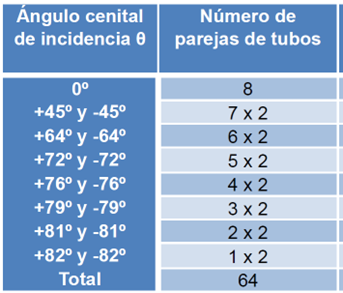How are data presented and how can they be downloaded?
From the beginning, we wanted the data produced by the detector of the exhibition "In/visibility. Arturo Duperier and cosmic rays" exhibition of the MUNCYT to be available for the general public through a specific website: rayoscosmicos.muncyt.es
The data are presented in text file format (csv) with the following structure:

Fig. C1-1 A data file entry. Courtesy of Gustavo Martínez Botella
These are the columns:
- Event: is the event number counted from the startup of the data acquisition programme.
- Incidence angle: the angle of entry of the particle with respect to the vertical (0º) determined by the pair of tubes that have been triggered (see below)
- Coincidence: the identifier of the pair of tubes in which a coincidence has been detected (or the entire row of tubes for an angle of ± 90º, the horizontal).
- Time: official Madrid date and time of the event registered in the Raspberry Pi.
- Timestamp: the same, but with Linux time in seconds.
- Delta: time difference between consecutive events in seconds.
Given the geometry of the detector (two parallel trays with 8 tubes each and horizontal and vertical separations of 15.6 mm between adjacent tubes), there are 64 possible coincidences between pairs of tubes, one from each tray, which define the following cosmic ray incidence angles with respect to the zenith (0º):

Fig. C1-2: Angles of incidence depending on the pair of tubes to be activated. Courtesy of Gustavo Martínez Botella.
To these should be added the coincidences with angle ±90º, defined between all the tubes of one of the two trays.
The following questions present the issue of the geometry of the tubes in the detector making the immediate interpretation of the angular distribution of the events difficult and then a brief tentative introduction to some analyses using the first 10 000 events recorded during the detector tests in April 2022 (courtesy of Gustavo Martínez Botella).
(1) As was done with the detector at the Virtual Visitor Center of the SLAC laboratory (https://web.archive.org/web/20080914075038/http://www2.slac.stanford.edu/vvc/cosmicrays/crdctour.html) and is currently done with the CosMO Mill detector of the DESY laboratory: https://www.desy.de/school/school_lab/zeuthen_site/cosmic_particles/experiments/cosmo_mill/index_eng.html

